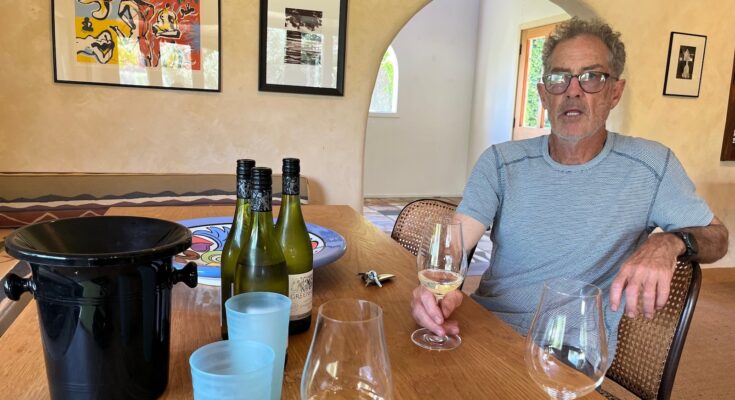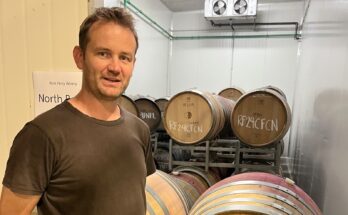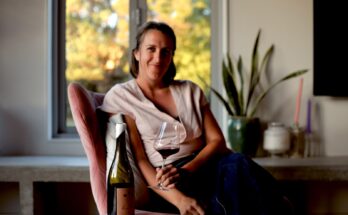I’m sitting in the beautiful room at Greenhough cellar door, and it is quite a lovely early afternoon as well – despite last night’s rain in Nelson. I’m here to talk to Andrew Greenhough, and as you do, we start off talking about the weather..
Winefolio: My apologies for bringing Auckland weather with me on the trip – a few drops of rain last night. Did you need it?
Andrew Greenhough: Oh no – I don’t need any water at this time of year. We’re at that point where the drier it is, the better. As usual, we’re kind of looking like early – it keeps getting earlier and earlier every year. When we arrived here in 1990, our first vintages ran from the third week of April through the remainder of April and into May. But now, three weeks earlier than that, it is all over. Sometimes the Riesling isn’t until the end of March, but that’s it – all over. But the weather is somehow more volatile these days.
WF: I do tend to refer to Climate Change, not just Global warming. ‘The crazy’ seems to be more, and more often. The chaos seems to be increasing.
AG: It does. There’s always something, somewhere in the world. Flooding, fires, extremes.
WF: Making great sparkling wines in England now!
AG: Yes – I subscribe to ‘Vinous’ and I saw something come up. I like Neal Martin’s writing, and there was an article about UK bubbles. Seems like 80% of what they do is bubbles.
WF: I have been researching UK wines over the Summer. I was there in August last year, and saw some bottles in shops that got me interested, and I’d like to go back with a bit more knowledge and have a poke about. I’m seeing Greg Day here in Nelson tomorrow, and he’s connected with Boutinot isn’t he? An English company. I did hear that the Taittinger wine from England is finally being released this month, after ten years.
When I worked at the Wine Bar and cellar in Devonport – we used to stock Greenhough wines and I do remember that the Pinot Blanc was very popular – we’d have a couple of customers calling in to buy it, specifically. And the Apple Valley Riesling went well too.
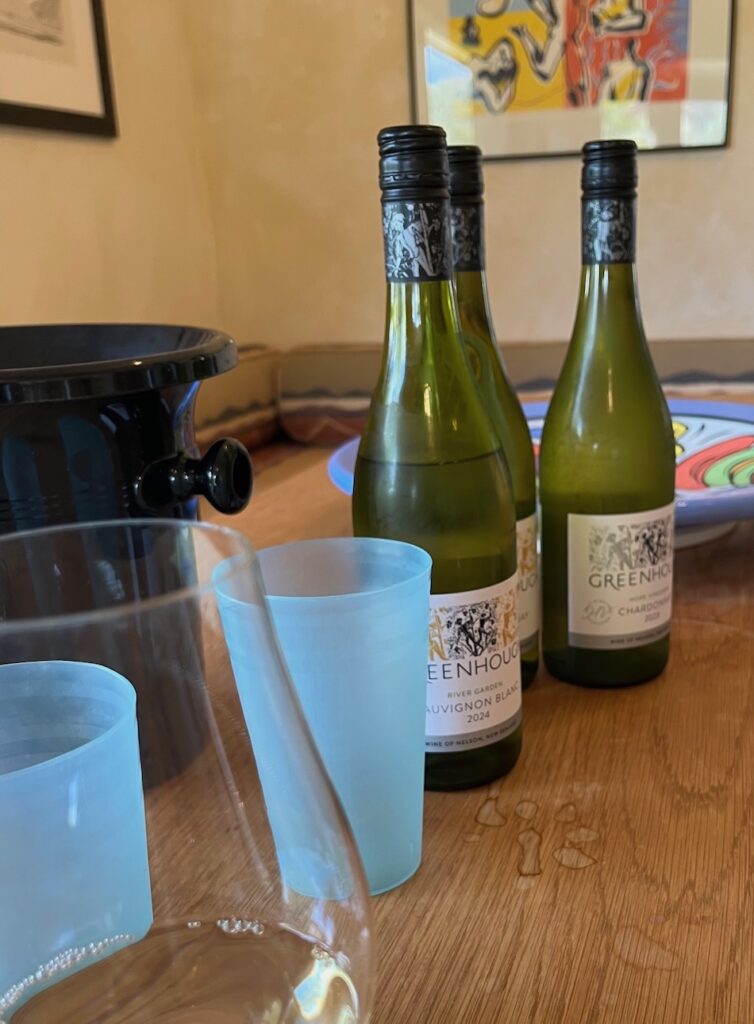
AG: We used to make a dry riesling as well as the off-dry style. Volumes were small anyway and we decided that we were better off putting it all into the Apple Valley style because that’s what people wanted. A lot of people say that they drink ‘dry’ but…(laughs).
This is our ’24 Sauvignon. A good year – actually we’ve had a good string of years. ’21 was excellent. ’22 probably wasn’t as good. But the others – and this year is shaping up well too as long as we don’t get any more rain. Climate change has had a few effects. There’s been some sub-tropical cyclones that have come through – like in ’22, and they just create havoc. If the fruit is three weeks away from harvest… all it wants to do is start to rot. That’s the problem we had in ’18 and ’22, but since then…
We’re very free-draining here – we have a clay-loam topsoil mixed with gravel, overlaying river stone. Pretty difficult to work! We converted to organics in ’08, and certified in 2011. One of the reasons we had put off moving to organics was that we just didn’t know how we were going to deal with the under-vine weed issue, because the ground is so stony. But there’s a lot of good gear out there now. It’s not about the cosmetics. Under-vine mowing can work, and it keeps the weeds out of the vine heads, but it doesn’t deal to the root system. That means a lot of extra competition and vines just become de-vigorated and less viable. We’ve taken to an under-vine cultivator, which is great.
WF: I hear people talk about ‘taking ten years to understand the vineyard’ – is that something you think?
AG: I’ve never really been anywhere but here. But I am, for sure, still learning about it, yes. I guess you get a sense of which areas need extra attention. Because it is ancient alluvial, the ground is quite variable and you see it in the vines. In terms of vigour, and colour. Mostly what I learn is the importance of timing, really. The way that you set out and respond to the seasonal variances and time your various operations so that they are effective and timely. And that you’re not trying to play catch up – that’s a big part of it.
When you go organic, you have a very limited range of chemical products that you can use, and it’s all based on contact, so you’ve to get that spray to contact your leaf and fruit. So the timing and amount of leaf removal, not only for ventilation, but the accessibility to the spray becomes a critical factor in control of disease. You just keep refining those things. You refine your spray programme. It’s one of the reasons I took on organics – because it was a new way of looking at and approaching the vineyard. And it has been.
WF: I imagine there’s been plenty of changes along the way?
AG: We inherited two acres of vines that were planted back in the mid-70’s, so that’s what we cut our teeth on, as novices. But they were Cabernet Sav, Gewürztraminer and a lot of Müller Thurgau. But it was fruit, and it was there, and we could make wine out of it. So we learned stuff from it. But that’s mostly gone – given way to Pinot, Chardonnay and Sav Blanc. And a little bit of Pinot Blanc, because that was here and we liked it and took cuttings and grafted some up.
WF: What do you think of writers, like myself, who review and score wines?
AG: Often you’ll get a description of a wine that you think sounds wonderful but the score is not as high as you’d expect.
WF: The problem is, with the description… I’ll just do a stream of consciousness – whatever I think of it… then I get to the point where I need to allocate a score, and suddenly, it’s all about context. You start with ‘is it 100/100?’ and then think about where it sits in context to other wines you’ve looked at, and it gets a score. I am aware that sometimes there seems to be a disconnect there. I find the review quite easy… but the whole thing – can be conflicting.
AG: I suppose that’s the thing about wine criticism. You get to know certain critics and, as I said, I read Vinous and Robert Parker. You soon get a sense of what that reviewer likes and doesn’t like. And you soon get a sense that 91 to 93 is a very good wine, but it takes quite a look to push them beyond it. And so one point, or two points more can be significant. Some markers are hard and some aren’t.
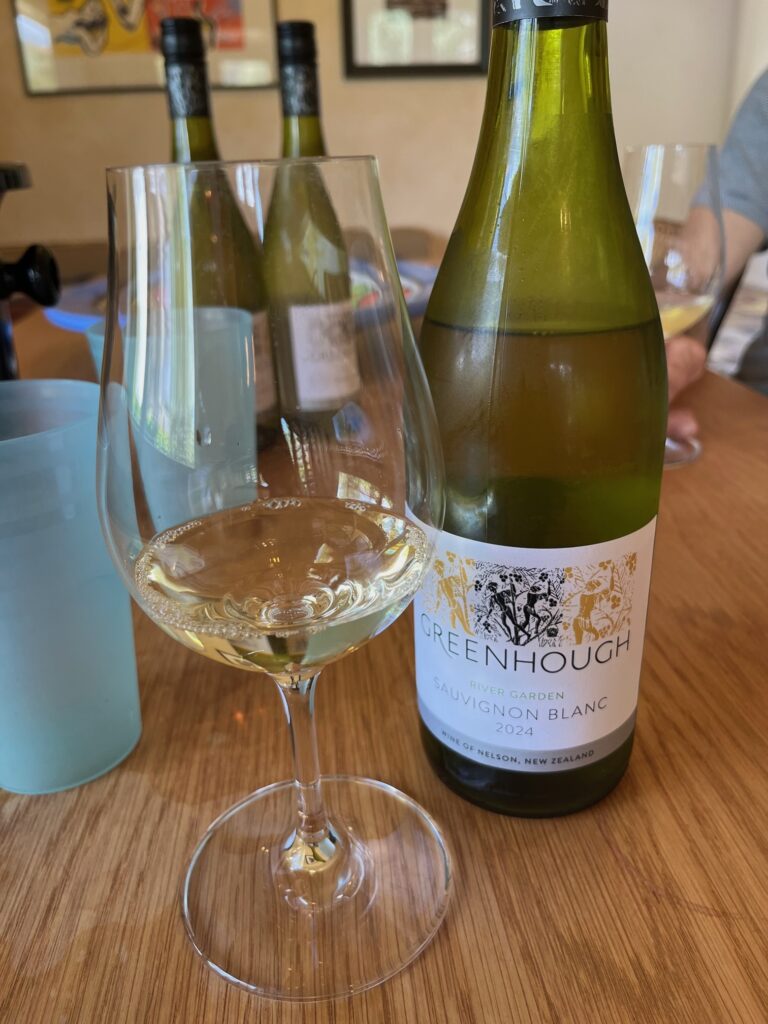
WF: Galloni is Vinous isn’t it? His scores are enormous!
AG: Yes – too high.
WF: I gave my first 100 point score recently – to a Kumeu River Hunting Hill 2010. It was in the middle of an enormous tasting – around forty wines I think. And a murmur went around the room as people got to it. I’ve drunk some very good wines, and a lot of the ‘greats’ when I lived in Europe, but you know when you hit something that you cannot fault – it makes a mark. I had a very good New Zealand Pinot last year – Daniel Kemp opened a ‘Ma Maison’ from Martinborough that was quite notably good.
AG: Yes, I like Martinborough for Pinot. I feel a bit sorry for Martinborough as they got a bit forgotten about once Central Otago made its mark. They all pulled together there and did a great job. It’s hard to beat really. Central Otago compared to Martinborough – a lot of the wineries are very well resourced, and staffed. And there’s money spent that goes for Marketing as well as wine production. In Martinborough it feels like smaller producers who are very much involved in the day to day. They don’t all have winemakers or sales staff. They do a lot of it themselves, like we do.
WF: I do think though, that if you look back fifteen years ago – and I’m a big fan of cellaring wines – and they were making wines like ‘they could’, but was it really what ‘they should’? In Europe, Pinot is a medium-bodied aromatic red… but the wines here were very big.
AG: Yes, but everyone was doing that. Everyone was trying to make the biggest Pinot they could, because they were tailoring it to red wine drinkers. The market was young and a bit naïve, and perhaps didn’t appreciate how different Pinot was. Then there was a change and a move towards way more elegance, and less extraction and lower oak. And it’s still happening.
WF: How are things in Nelson for wine these days? I’ve been planning to come here for what seems like ages, and I actually feel like there’s less here than I had thought?
AG: Well, there was a huge amount of development in the mid-90s. New vineyards being planted, new labels. Nelson has always been small scale – just Seifried and Waimea are bigger. Everything flourished and that continued right through the 2000s and 2010s. And over the last seven or eight years I guess, the odd one has struggled. Some others – Dave Glover, for example, died, who was one of the originals. There were some sales and amalgamations. There was a big start-up by an American multi-millionaire that recently went under – Mahana.
Beth Eggers who owned Himmelsfeld is a classic example. Started in mid-90s, and was very small – did her own thing. And I think has been there until quite recently. Got involved with some Chinese company – making Chardonnay for them under some label. Then there’s Blackenbrook, and they had a marriage break-up and it has turned pear-shaped for them. So one way or another we’ve probably lost eight to ten brands.
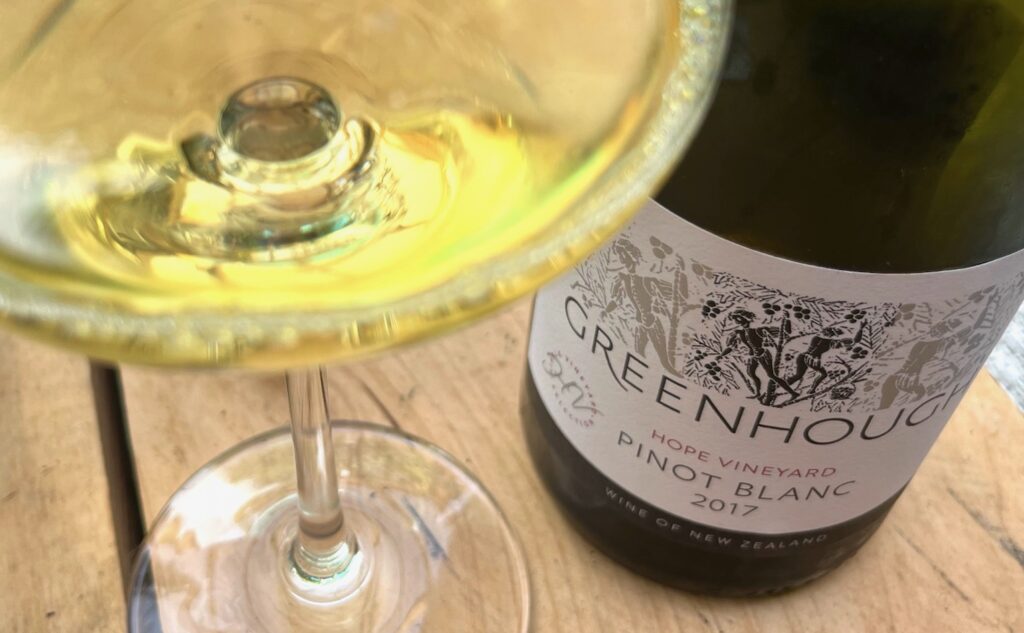
WF: I assume there’s a local Winemakers Association?
AG: There is, and it is reasonably strong. One of the things about Nelson is that it is people like me, and smaller operators who are family-owned and operated. Lots of it is very hands-on and we don’t have big staff and the ability to do all these big promotional ventures that take the region further afield. We don’t have the resources to do so. You’re doing enough things as a small winemaker as it is. Wearing a lot of hats. Growing the grapes, then making the wine, then selling the wines. Selling has become a job in itself.
WF: And of course Marlborough is now working on their ‘sub-regional’ identities.
AG: I guess you could say that has been a defensive mechanism that has been instigated by some of the smaller producers who don’t want to lumped together with the corporates. You look at someone like the Herzogs. Gosh, they’re still there doing it the way they’ve always done it. I follow their Instagram and he’s still out there, like I am. Doing everything hands-on. Good on him – I know exactly where he’s coming from. But I also see them being quite active in the market – personally. They go out there, and are out in Auckland a lot. Directly talking to the right restaurants. I think they’re having to maintain that profile to maintain the pricing – to maintain that quality.
WF: I know they have assistants that come in for the busy periods, but you get the impression that if he could do it all himself – physically – then he would?
AG: Like me too. you would rather do it yourself, but you just can’t. There’s a reality. And the older you get, you have to be realistic.
WF: What’s the best bit of the year?
AG: Oh… vintage. The month that you’re harvesting that fruit and bringing it in. Given that it is a successful vintage. That is a really good time of year. The satisfaction and the relief. It’s lovely when the winery is full of fruit.
And… I really do enjoy something like pruning. It is quite stimulating. And it is a nice time of year in the sense that life is simpler. All you’ve got to do is prune. You’re not doing all the other multiple jobs that are happening, because the pressure is off a bit – the wines are in the cellar. You know when you are pruning a block, when it is balanced and growing well, and in good shape because the pruning is so much easier and quicker. There’s less having to approach every single vine as a new case study.
The stimulation is that you are making a lot of decisions and thinking ahead. You’re setting yourself up in the best possible way using all the knowledge you’re gained. And you’re always optimistic. But you don’t know how the bud burst is going to be. Or how dry, or wet it is going to be. Sometimes things aren’t quite as good as you’d hoped. But, at the same time, you get really good at adapting to the season.
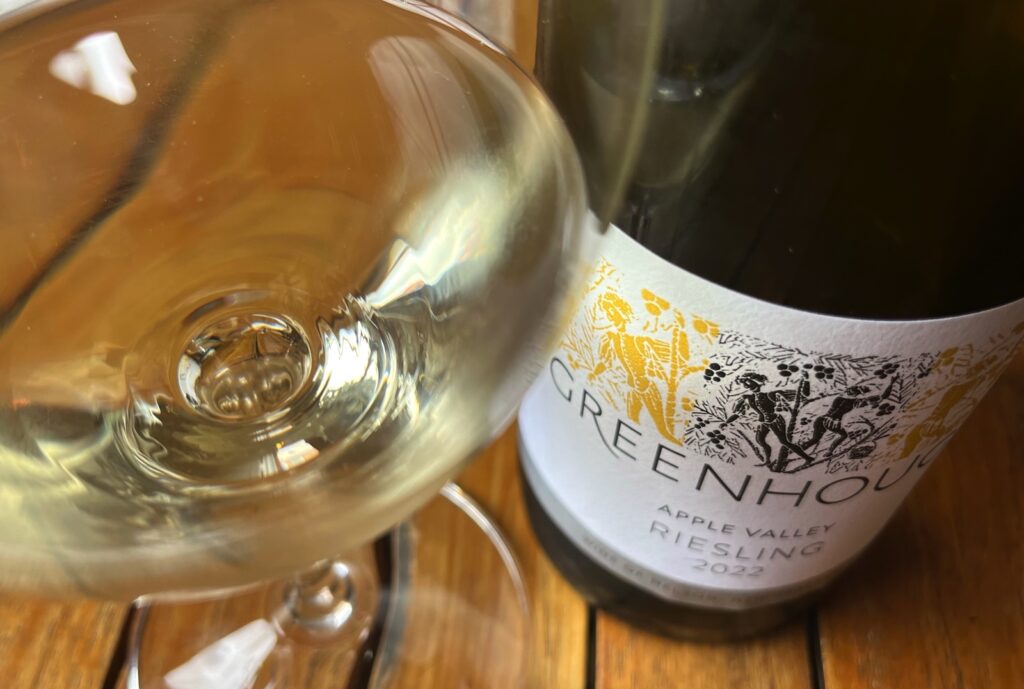
WF: Is there anything that you look back on and wish you’d done differently?
AG: I wouldn’t have planted as much Sav Blanc. I’d have focussed more on Chardonnay and Pinot. That’s hindsight. I look at what’s happened in Marlborough and I wish it hadn’t happened that way. I wish there had been a bit more regulation around it so it wasn’t all quite so runaway.
WF: Is there anything in the New Zealand wine industry that you would change if you could?
AG: Regulation probably. I don’t have a problem with the big boys. They take the wines further afield and make it accessible. But I feel there should have been some regulations over yields. The tonnages are just ridiculous. I think more regulation would be a good thing. It works in Europe. And the world is awash with wine at the moment. They’re being paid to pull it out in Bordeaux.
WF: Any thoughts on what are the big challenges ahead for the world of wine?
AG: There are a lot. There’s so much negativity about alcohol. You only need to listen to Radio New Zealand and there are so many interviews and features that revolve around alcohol. Guy Espinor – ‘given up drinking’ podcasts. Wine needs to somehow differentiate itself from other forms of alcohol. To some extent it is justifiable to do so. It is one reason I’m disappointed that there has been a lack of regulation, and it has been allowed to become a ‘cheap commodity’. Because all it has done is placed it in amongst the cheap forms of alcohol that are there for people to get pissed on. I think it is important to continue to somehow promote and brand wine as a ‘drink with a difference’.
WF: So, tell me about these two in front of me?
AG: The Hope Vineyard is a vintage selection. In the Pinot and the Chardonnay we make, as an Estate wine, the Roadblock and Stones Throw for the Pinot. And the Hope Vineyard selection wine from them, if the year warrants it. It’s a barrel selection but it is not pre-meditated. It will vary from year to year, depending on what clones have performed well in that season, and look best after their time in barrel. We keep all the blocks separate, ferment them separately and get a chance to look at them as relatively complete wines a year down the line and make blending decisions.
I think, with the Hope Chardonnay, we generally look for something that’s a little more powerful in terms of fruit concentration, but also retains a nice elegance and refined restraint. We’re not necessarily looking for more new oak in that wine. Sometimes we’ll even reject some of the barrels that are of the same fruit, but just the newer oak, because we don’t want to overwhelm it. I look to promote some of those more citrus characters. I feel this wine has more breadth and simplicity. That’s where it fits price point and in the market.
WF: Do you have wines that you benchmark yourself against, or aspire towards – that have inspired you?
AG: A lot, over the years. I’m a big fan of the Kumeu Rivers. I’ve always thought they’ve been delicious, reliable, age-worthy wines. I’ve always loved the local Neudorf Chardonnays. I have learnt though, that my Chardonnay isn’t Neudorf and never will be. It is grown on a different site with completely different soils, so will never have the same kind of richness that the clay produces. But at the same time, what theirs won’t have is a sort of linearity and drive.
That’s 100% Mendoza and as you know, Mendoza is a clone that retains higher natural acidity and lower pH at harvest. So you do get nice drive and you do get some impact out of the fruit. The other thing we’ve done over the last decade is to pick the fruit earlier. If anything I think the warming of the climate has enabled that, and we’re able to pick the grapes at slightly lower sugar levels, but the acids are riper. That balance works.
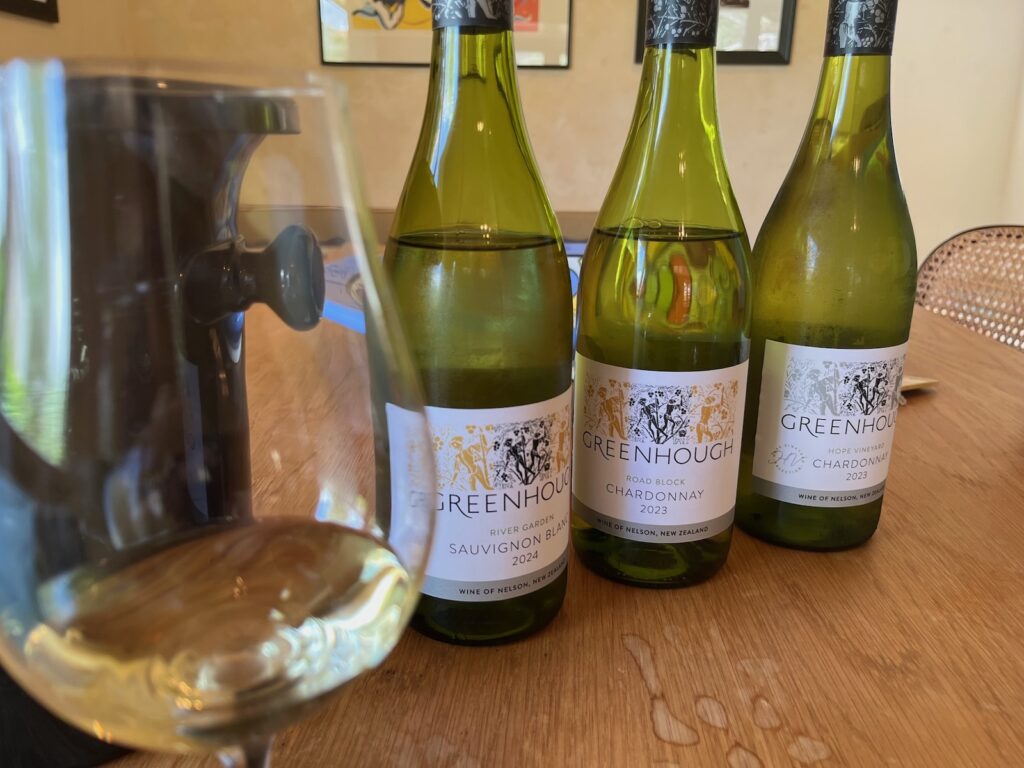
WF: Are there any other wines that you’d like to have a try at?
AG: I’d love to be able to plant some Sangiovese or Nebbiolo! That would never work though. I love those wines! I’ve been happy enough focussing on the limited range I make.
WF: Do you cook?
AG: Oh yes, Jenny and I are both right into cooking! And eating well – fresh, tasty and healthy. We like a good Campari and soda, or a Gin and tonic. We have a little wine group of half a dozen friends, and some of them are into their whiskys. I buy a bit of Burgundy when I can afford to – from Peter Maude, and cellar it.
WF: Are there any fine wine stores in the region where you can get something worth drinking?
AG: No, that’s gone. We used to have a very nice wine shop down here. It was called Casa del Vino and it was run for many years by a lady called Anne, and used to have regular tastings where she’d bring various outside winemakers, or Jean Christophe, and that was good. We had a locally-owned supermarket in Richmond that had a fantastic wine and beer selection. It’s gone.
WF: Do you get to travel much?
AG: A recent trip to Alto Adige, which was lovely. I loved their wines – the Kerner, the Pinot Blanc. Stunning place. The Dolomites are spectacular – we did some walks. I brought a few of those wines home with me. I’ve done some nice trips to Japan. Mainly working with our importer, but these trips always involve as much downtime as you can possibly wangle! It’s a lovely place to visit. I’d like to go to Galicia – that’s on my list. I love Albariños. On the same trip where we went to Italy, we did this beautiful drive from Shrewsbury down the welsh borders, but on the English side, down to Bristol. The countryside and the villages and scenery are just amazing.
WF: What sort of things do you do when you’re not growing, or making wine?
AG: Selling wine! (laughs). But no, we walk a lot – this region is excellent for that and we’ve attacked a good few of the Great Walks over the years. We do the Nelson Lakes – it’s beautiful. There’s so much complexity to it, with so many trails.
WF: You’re into music too?
AG: Yes, I’ve been listening to that podcast ‘The History of Rock ’n’ Roll in 500 songs’. Oh, it’s so good. It’s done by the same guy – I think he’s a liverpudlian – and he’ll take a song like ‘Sympathy for the Devil’ by The Rolling Stones, and he’ll use it as a springboard for not only talking about the song and the band at that stage in their careers, but introducing other music that was happening. And historical, current events – anything that might weave into the story and make the song the catalyst for it. It’s really well done.
The more you listen to it, the more everything will start to inter-relate. So when he’s talking about The Kinks or The Byrds or The Monkees… little bits – whether it’s a Manager or a Record Label will come into the story. And over time as you listen to it, it will all reinforce itself.
WF: I miss really good broadcasting and journalism. I long for that. Being brought up in a golden era of it – in the UK – it is such a shame, the state of things now. People in positions of prominence with minimal journalistic skills. Maybe it is things like podcasts where people with talent have retreated to. Because mainstream media now is garbage. Even in pop culture – I saw recently something pop up that was Charles Shaar Murray’s review in the NME of Joy Division’s ‘Closer’ album when it was released. Now that is proper writing. I was schooled in that sort of thing – worked in publishing all my life – being mentored by old school journalists. And it kills me to see the lack of depth to what people read now – influencers and the like.
Last question – if it could be anyone – who would you most like to share a glass of your wine with?
AG: Someone who was knowledgeable about wine, and had something that I could learn from having a glass of wine with them. Someone like Neal Martin. I’m sure the feedback wouldn’t be very favourable, but at the same time it would be interesting. Perhaps he’d be setting the benchmark a little high in the sense that he’s has tried every great wine under the sun. The advantage of sitting with someone like that would be that you would have the benefit of that context – to get some constructive feedback about your wine. As long as I could choose the wine and try to do myself justice!

